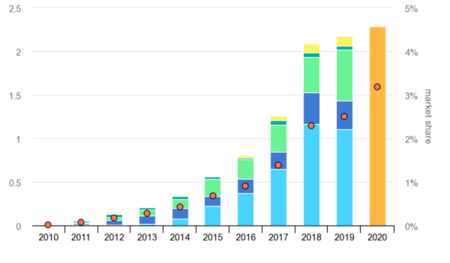The transport sector is one of the largest contributors to greenhouse gas (GHG) emissions and air pollution, globally. Many governments have already taken steps towards decarbonising the sector. Zero emission vehicles (ZEVs) can play an important role in reducing carbon emissions and achieving a green recovery from the COVID-19 pandemic.
The pandemic has caused deep economic repercussions, limiting public budgets and shifting government priorities. However, it has also shown how quickly emissions can be reduced once polluting vehicles are off the roads. The post-pandemic recovery presents a unique opportunity for city, state and national governments to improve transport systems and take advantage of the benefits ZEVs can offer to restore the economy.
The ZEV transition is accelerating
The electric vehicle market is developing rapidly. Sales soared from 450,000 in 2015, to 2.1 million in 2019 and are predicted to reach 26 million by 2030.
Despite the economic impacts of the COVID-19 pandemic, the ZEV market has remained resilient and continues to grow. This is particularly striking when considering that, in some countries, sales of internal combustion engine (ICE) vehicles plummeted more than 90% during the same period.

As the virus spread and lockdowns were declared, car sales and manufacturing decreased sharply. Regardless of this, the latest IEA report shows that EV sales quickly rebounded after an initial drop during the first few months of 2020. EV sales are, in fact, expected to slightly exceed 2019 sales, taking a record share of 3% of the overall market in 2020.
In face of the current crisis, countries including Germany, France and Italy have already implemented strong auto industry recovery measures with specific provisions for electric mobility. The cost of owning an EV is becoming more competitive due to falling fuel prices, and government incentives at the national, state and local levels can help abate the high purchasing costs.
ZEV policies can stimulate the job market
Shifting the auto industry towards ZEVs can lead to the creation of green jobs. IRENA’s post-covid recovery report emphasises the creation of new job opportunities in the EV sector and support for reskilling workers from the fossil fuel industry as measures that will bring positive economic results.
Looking at specific activities to achieve the most impactful results, the IEA’s Sustainable Recovery report shows that charging infrastructure and battery cell manufacturing have the largest job creation potential, followed by pedestrian and bike lanes. This indicates that the ZEV transition is a positive step towards addressing the post-pandemic unemployment rates.

Investments to improve public transport systems – including the expansion of high-speed railway networks as a more sustainable alternative to aviation – can also create job opportunities in construction and engineering. In addition, low-emission zones in city centres and electric bus fleets contribute to the reduction of air pollution levels caused by transport, having a positive impact on public health.
Government action at all levels is essential for a successful transition to ZEVs
Although the transition to ZEVs is progressing, stronger government action is necessary to ensure it happens fast enough. Governments need to lay down the necessary foundations to accelerate the shift in the private sector and signal the transition to the market.
The IEA has identified two alternative scenarios for the future of ZEVs. One is bleak, considers current and weakened government policies as a result of the crisis and unaddressed behaviour changes. The other is bright, compatible with the goals of the Paris Agreement, considers the implementation of green recovery measures and policies at all levels of government.
Businesses also play a major role in the low carbon transition, and ZEVs can be instrumental in reducing a company’s environmental impacts.
The main obstacles cited by businesses for the uptake of ZEVs in company fleets are:
- lack of EV supply to meet demand (particularly for heavy duty and specialised vehicles).
- lack of robust charging networks to support long distance journeys and access remote areas.
Governments can address these obstacles by:
- signalling upcoming EV demand to car manufacturers, businesses and investors through supportive policy action;
- unlocking the flow of capital into ZEV manufacturing and infrastructure roll-out;
- making long-term commitments, such as the announcement of petrol and diesel phase-out dates, the implementation of fuel economy regulations, EV mandates and urban policies.
ZEVs contribute to improved air quality and public health
A large percentage of global transport emissions are caused by on-road transportation which is also linked to a myriad of health problems associated with the release of harmful particles and gases into the air.
ZEVs play an important role in reducing GHG emissions and levels of air pollution as they are more energy efficient and do not produce any tailpipe emissions during use. Their quiet engines also contribute to decreased noise pollution, therefore reducing noise-pollution-related health problems across the world.

According to IEA statistics, the generation of electricity required to fuel the global electric vehicle fleet in 2019 resulted in half the GHG emissions that an equivalent fleet made up of internal combustion engine vehicles would have created. As countries and states move towards a more renewable energy system, emissions from electric vehicles will reduce further.
ZEVs have also been found to have a better environmental performance (22% cleaner) than diesel vehicles even in the worst-case scenario - a car running in one of the most carbon intensive grids, and where batteries were produced using the least sustainable materials and processes.
Governments should act on ZEVs for a green recovery
The COVID-19 pandemic has proven the resilience of the ZEV market. However, action to accelerate the market now is critical to secure its future success.
Governments at all levels must incorporate ZEV policies into their green recovery plans. They must also support businesses to overcome barriers, implement ambitious mandates and set both short and long-term targets as they work towards a low-carbon energy system.
With robust ZEV policies in place, governments can strengthen their economy, create jobs and successfully achieve both their long-term environmental and public health goals.
